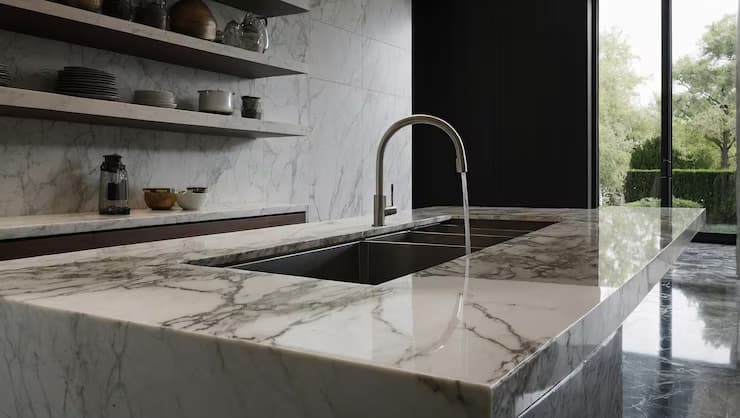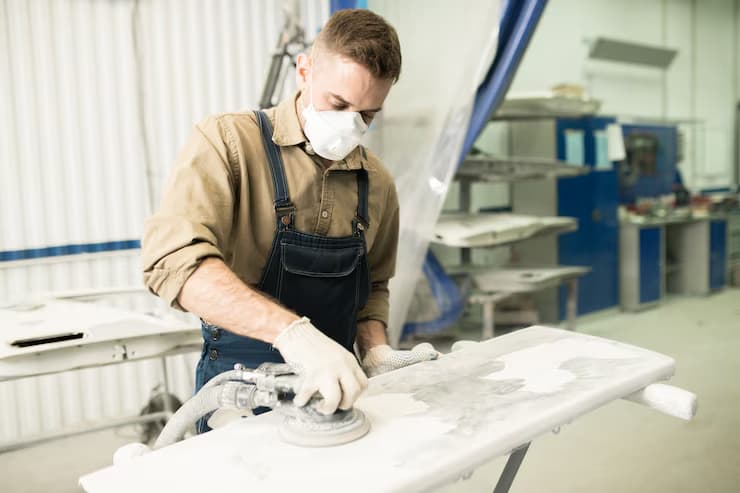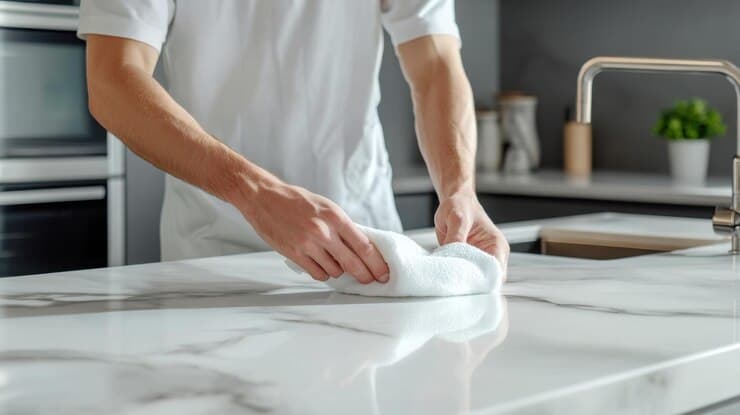Marble countertops shine and bring sparkle into any kitchen or bath. Smooth surfaces and rich colors make them the most common in homes. But caring for marble is quite sensitive.
Marble may become stained, scratched, or lose its glow if it is not cleaned properly. Water marks, food spills, and scum from soap can be common issues. The good news? Just the right tips and tools can keep your marble shining!
This ultimate guide will show you how to clean marble countertops safely and pick the best cleaners. You’ll also learn how to remove tough stains and choose the right sealant to protect your marble.
Here, you will also receive instructions about caring for marble tiles in bathrooms and remedying water marks before they become permanent.
Understanding Your Marble Countertop

One type of natural stone is marble. It forms when limestone is heated and compressed deep beneath the earth over long periods. That transforms marble into its soft appearance and stunning designs. Every marble slab is unique. No two are alike. That is why marble countertops are so distinctive and valued in so many homes.
What Makes Marble Special
Marble is smooth and cold to the touch. It has delicate veining that is stunning and opulent.
It is available in various colors such as white, gray, black, and even green and pink. This stone is usually applied in kitchens and bathrooms since it appears luxurious and brings beauty into any setting.
But marble is porous and soft. This exposes it to scratching and liquid absorption. You should therefore treat it gently.
Why Marble Needs Gentle Care
Marble is different from hard stones like granite. It stains from foods such as tomato sauce, wine, or lemon juice. It also scratches with sharp tools or rough scrubbing. Even water can mark if not cleaned fast enough.
Due to this, marble must be cleaned carefully. You need not use abrasive cleaners that contain acid, bleach, or vinegar. These can etch the surface and make it appear dull. Use soft cloths and gentle cleaners at all times to maintain marble’s nice appearance.
Types of Marble Finishes: Polished vs. Honed
Marble can be finished in various ways. The two most well-liked ones have been refined and refined.
Polished Marble
- This finish is smooth and glossy. It glows in the light and looks highly sophisticated.
- However, it also highlights stains and scratches very easily.
- Polished marble is ideal for areas where you need a clean and glossy appearance.
- Polished marble tends not to absorb stains as easily compared to its honed counterpart. However, the shining nature of polished marble proves to be a disadvantage while being cleaned.
- Polished marble easily shows streaks made during cleaning. Honed marble surfaces do not easily show streaks after cleaning.
Honed Marble
- The honed finish of marble is satiny and flat. This texture reduces slipperiness and allows a better grip compared to polished marble.
- Honed marble provides greater light diffusion and, in a way, helps reduce the reflection of streaks.
When choosing a finish, also think about your marble countertops color. Some colors look better with a polished shine, while others work well with the soft, natural look of a honed finish.
Coat Your Marble

Marble surfaces require sealing to prevent any stains from various substances. Therefore, sealing prevents staining marble.
There are two ways to go about sealing marble as follows:
1) Impregnating and penetrating sealers are absorbed into the stone to afford it protection against both water and oil from penetrating.
2) Topical sealers create a barrier by covering the stone’s surface. These are not recommended for marble since they can split and expose the stone to staining.
Both types can be reapplied using the same methods employed for their initial application.
How to Keep Your Marble From Getting Stains
All marble countertops should be sealed against staining. It becomes stain-resistant if it is sealed.
Therefore, two sealants for marble countertops have been available that can seal marble:
1) Sealant impregnating and penetrating protects the stone from penetration of any oil or water.
2) Topical sealant lies on the surface of this stone and barricades it from these contaminants; however, they carry risks and are not to be used on marble, since it may crack and expose the stone beneath to stain.
Both methods allow for reapplication in the same manner as their initial application.
Daily Care Routine for Clean Marble Countertops

Protecting your marble countertops might best be done by daily cleaning. A few simple steps will make your marble sparkle and look great for years to come.
How to Wipe It Down Safely for Marble
Water and a small amount of cleaner should be used to damp the marble surface after it has been cleaned with a cloth. Use warm water and a normal amount of the top-rated marble countertop cleaner for best results. The cleaners are designed to be gentler on the marble surface. They clean dirt and minor spills and are safe on the surface.
Do’s and Don’ts of Daily Cleaning Recipes
Do’s:
- Use a soft cloth or sponge.
- Spills should be cleaned immediately.
- Marble cleaner should be used.
- The surface should be dried after cleaning.
Don’ts:
- Vinegar, lemon, and bleach cannot be used.
- Don’t allow spills to sit too long.
- Don’t use general cleaning products from the kitchen—they’re too abrasive.
What Clothes and Tools Are Best to Use?
Microfiber cloths are used for most cleanings. Soft, safe, and highly absorbent for dirt. For big messes, a soft sponge or non-scratch cleaning pad would be just right!
Keep the best marble countertop cleaner in spray bottle form available for those spur-of-the-moment cleanup chores. Keep dry cloths around to wipe up excess water or cleaner.
Daily upkeep doesn’t take a lot of time, but it makes a great difference. With the right tools and cleaners, your marble shall always shine!
How to Get Stains Out of Marble
Marble is beautiful, but it can stain easily. Because marble is a soft and porous stone, liquids can soak in and leave marks. But don’t worry—most stains can be removed with the right steps.
Let’s go over the most common types of stains and see how to remove stains from marble.
Common Stain Types
There are the following common stain types
1. Oil Stains
These come from cooking oil, butter, or lotions. They can make the marble look darker in spots.
2. Wine or Juice Stains
Red wine, grape juice, or coffee can leave colored stains on marble. These drinks have acid and a dark color, which makes them hard to clean if left too long.
3. Food Stains
Foods like tomato sauce, mustard, or berries can leave marks if spilled and not cleaned quickly.
4. Rust Stains
Metal items like cans or tools can leave orange or brown rust stains on marble.
5. Water Rings or Etch Marks
These happen when water or acidic liquids sit too long. They don’t leave a color stain but can make the marble look dull or cloudy.
Step-by-Step Process for Removing Difficult Stains
Removing tough stains from marble may take time, but it’s worth the effort to keep your surface looking beautiful. Using the right steps can help you avoid damage and save the cost of hiring a professional.
Clean the Location
First clean the marble first, so take a cloth dip into awarm water and clean it. Wash it well to get rid of loose dust and dirt.
Put on the Marble Poultice Paste
One type of substance used to get rid of stains from marble surfaces is a marble poultice. Cover the stained area with the paste. The layer’s thickness needs to be approximately 1/4 inch.
Cover with Plastic Wrap
Cover the paste with plastic wrap.To keep the edges from moving, secure them with tape.
Let It Sit
Leave it there for 24 to 48 hours. This gives the paste sufficient time to remove the marble’s discolouration.
Remove the Paste
This gives the paste sufficient time to break down the stain on the marble.
Wipe and Rinse
Using a piece of cloth, scrape away any excess paste.
Repeat if Necessary
Certain stains require two or three attempts to completely disappear.If the stain is still present, repeat each step.
Removing deep stains takes patience, but it helps protect the beauty and life of your marble. Taking care of stains early can also help lower your overall marble countertops cost by avoiding expensive repairs or replacements later.
Marble Water Stains: How to Remove Them
Water stains can be caused on marble when water lingers on the surface for a long time. The stains are dull or ringed. Marble is water-absorbing and soft, so this happens. Hard water containing minerals may exacerbate the stains.
In order to avoid this from happening, always dry the marble after it has been cleaned or when a spill occurs. Don’t leave water on the surface. For the kitchen, put coasters under drinks. For the bathroom, put bottles and soap in a tray. Sealing the marble can also stop water from penetrating.
Now let’s talk about Marble Water Stains: How to Remove Them. First, try cleaning the area with a cloth and warm water. If it is still marked, put on a special powder marble polish. This powder won’t damage your marble and may be able to bring the dulled area back to its shine. Take a cloth and start cleaning by rubbing in a circle motion. If the stain is severe, you might need to use a polishing pad or seek the services of a professional marble technician.
With proper procedures, you can make your marble surface smooth and radiant. Water spots are simple to remove when taking good care of them.
Using the Right Cleaner for Marble Countertops
To maintain your marble in its new condition, you must use the correct cleaner. Normal kitchen sprays will harm marble since they contain harsh chemicals.Always use a product specifically formulated to clean marble countertops. These cleaners are safe and gentle on the surface.
When you done cleaning, spray a small amount of cleaner on the countertop and wipe using a soft cloth. Avoid anything with vinegar, lemon, or bleach. These will create dull spots or even mark it. A good marble cleaner preserves the shine and beauty of your countertop daily.
Sealing Marble: Why and How
Marble’s porous nature allows it to absorb liquids. That is why it must be sealed. Sealing lays down a barrier that prevents stains and water damage. It keeps your surface intact and makes marble countertop cleaning simple.
To seal marble, start with a clean, dry surface. Apply a natural stone sealant. Seal your marble once or twice a year, depending on use.
How to Clean Marble Tiles in the Bathroom

Bathroom marble tiles should be treated like a kitchen countertop. If you wonder how to clean marble tiles in the bathroom? So, never use water, soap, or hard water spots, as these will dull them. Always use warm water and a mild marble-safe cleaner to clean marble countertops or bathroom tiles.
- Seal your marble every once or twice a while based on usage.
- Use soft cloth or sponge for washing the titles. Dry them after they are used to avoid water spots.
- Use a pH-balanced cleaner made especially for marble for thorough cleaning.
- Never scrub because they may damage your marble surface and will leave the scratch.
- Keeping marble tiles clean provides your bathroom with a clean and crisp look every day.
Keep your marble countertops or tiles glowing for years! Just clean up spills fast, use gentle products, and seal often. It’s that simple to have them looking like new. A little care goes a long way.
Live in Columbus, Ohio? Call on Keystone Granite for professional assistance and amazing outcomes. Contact us for a professional guidance!
Conclusion
Cleaning marble countertops does not have to be hard. With good care, the right cleaners, and sealing, your marble can be beautiful for many years. Use gentle cleaners, remove stains properly, and clear up spills immediately. Daily maintenance is a miracle worker at keeping your marble sparkling and clean.
FAQs
1. What is the best thing to clean marble countertops with?
Use warm water and a few drops of mild dish soap with a soft cloth.
2. Is Dawn dish soap safe on marble?
Yes, Dawn is safe if used in small amounts and rinsed off well.
3. Is it OK to use Clorox wipes on marble?
No, Clorox wipes can damage the marble’s surface and finish.
4. How do I get my marble countertop to shine again?
Clean it well, then buff gently with a soft cloth and use a marble polish if needed.